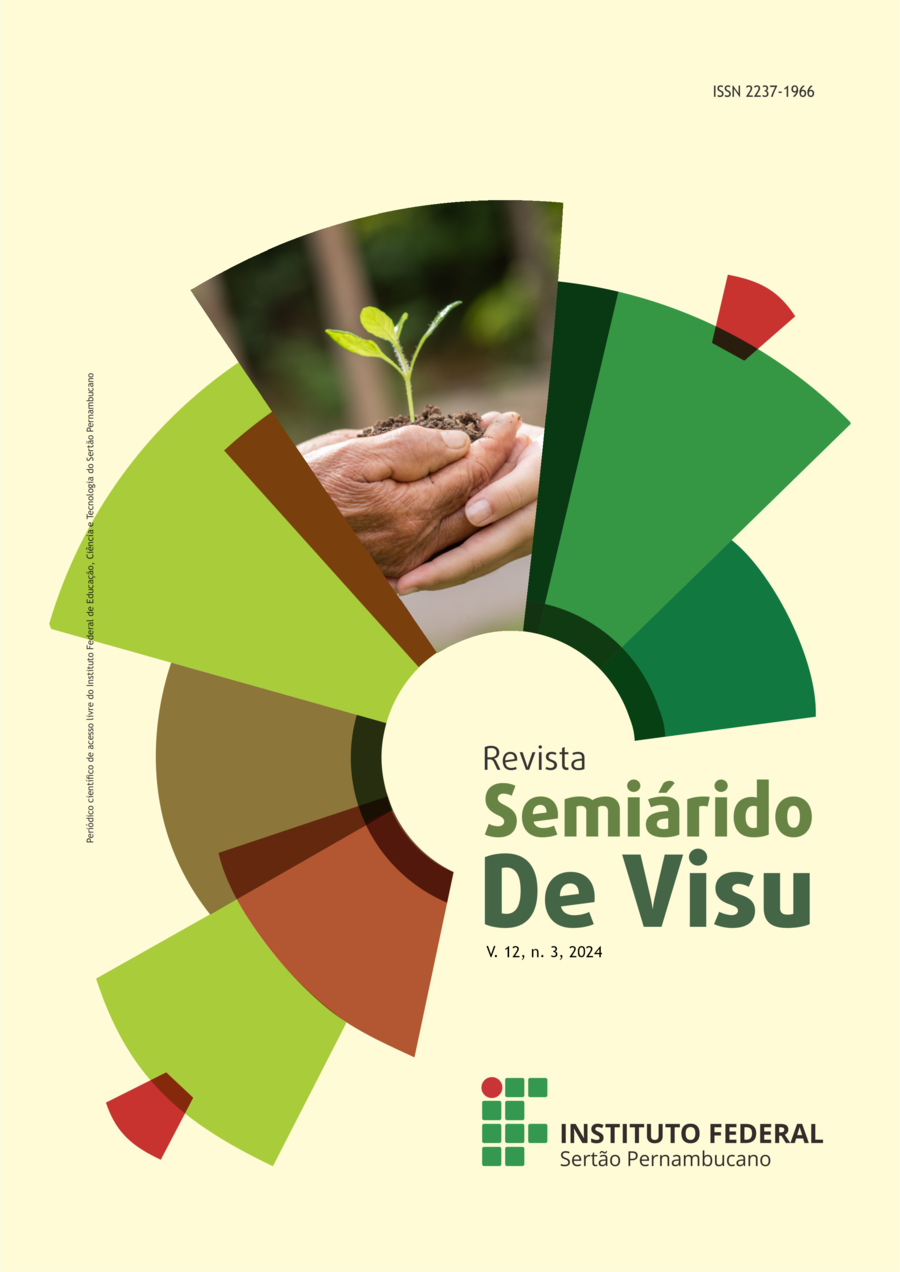A Antibacterial effect of yerba-mate leaves and twigs aqueous extract on pathogenic bacteria
Visualizações: 202DOI :
https://doi.org/10.31416/rsdv.v12i3.997Mots-clés :
Ilex paraguariensis, antimicrobial, residues, antioxidantRésumé
Antibacterial activity of yerba-mate (YM) and its industrial residue lacks deeper exploring. The objective of the work was to evaluate the antibacterial activity against pathogenic bacteria and polyphenolic content from YM leaves and twigs extracted for different periods. Staphylococcus aureus, S. epidermidis, Listeria monocytogenes and Escherichia coli were tested against aqueous extract from YM leaves and twigs and mode of action was evaluated by microscopy. Results showed that the aqueous extract of twigs inhibited both Staphylococcus species when extraction happened for 18h. The leaf extract showed inhibition against S. aureus. L. monocytogenes and E. coli were not inhibited. Extraction performed for 10 minutes did not yield antibacterial activity. No significant difference was observed in the concentration of total polyphenols or condensed tannins in the three evaluated extracts. Microscopy showed changes in the morphology of the S. aureus bacterial cell. YM and its byproduct is a promising source of functional compounds.
Références
BOUARAB-CHIBANE, L.B.; FORQUET, V.; LANTÉRI, P.; CLÉMENT, Y.; LÉONARD-AKKARI, L.; OULAHAL, N.; DEGRAEVE, P.; BORDES, C. Antibacterial Properties of Polyphenols: Characterization and QSAR (Quantitative Structure–Activity Relationship) Models. Frontiers in. Microbiology, v.10, e00829, 2019.
BORGES, A.; FERREIRA, C.; SAAVEDRA, M.J.; SIMÕES, M. Antibacterial activity and mode of action of ferulic and gallic acids against pathogenic bacteria. Microbiology and Drug Resistance, v.19, n.4, p.256-265, 2013.
BURRIS, K.P.; DAVIDSON, P.M.; STWART JR, C.N.; ZIVANOVIC, S.; HART, F.M. Aqueous extracts of yerba-mate (Ilex paraguariensis) as natural antimicrobial against Escherichia coli 0157:H7 in microbial medium and pH 6.0 apple juice. Journal of Food Protection, v.75, n.4, p.753-757, 2012.
CAXAMBÚ, S.; BIONDO, E.; KOLCHINSKI, E.M.; LAPPE, R.; BRANDELLI, A.; SANT’ANNA, V. Evaluation of the antimicrobial activity of pecan nut [Carya illinoinensis (Wangenh) C. Koch] shell aqueous extract on minimally processed lettuce leaves. Food Science and Technology, v.36, p.42-45, 2016.
DIARRA, M.S.; HASSAN, Y.I.; BLOCK, G.S.; DROVER, J.C.G.; DELAQUIS, P.; OOMAH, B.D. Antibacterial Activities of a polyphenolic-rich extract prepared from American cranberry (Vaccinium macrocarpon) fruit pomace against Listeria spp. LWT, v.123, e109056, 2020.
FLECK, N.; SANT’ANNA, V.; OLIVEIRA, W.D.C.; BRANDELLI, A.; VERAS, F.F. Jaboticaba Peel Extract as an antimicrobial agent: screening And stability analysis. British Food Journal, v.124, n.9, p.2793-2804, 2022.
FLECK, N.; OLIVEIRA, W.C.; PADILHA, R.L.; BRANDELLI, A.; SANT’ANNA, V. Antimicrobial effect of phenolic-rich jaboticaba peel aqueous extract on Staphylococcus aureus and Escherichia coli. Brazilian Journal of Food Technology, v.26, e2022087, 2023.
GIRARDI, I.; PADILHA, R.L.; SANT'ANNA, V. Sugarcane bagasse: analysis of polyphenols, compounds with antioxidant and antimicrobial activities. Tecno-lógica, v.23, n.1, p.59-62, 2019.
JONES, G.A.; MCALLISTER, T.A.; MUIR, A.D.; CHENG, K.-J. Effects of Sainfoin (Onobrychis viciifolia Scop.) condensed tannins on growth and proteolysis by four strains of ruminal bacteria. Applied Environmental Microbiology, v.60, p.1374–1378, 1994.
KHAMENEH, B.; IRANSHAHY, M.; SOHEILI, V.; FAZLY BAZZAZ, B.S. Review on plant antimicrobials: A mechanistic viewpoint. Antimicrobial Resistance and Infection Contamination, v.8, n.1, e118, 2019.
KHORSHIDIAN, N.; YOUSEFI, M.; KHANNIRI, E.; MORTAZAVIAN, A.M. Potential application of essential oils as antimicrobial preservatives in cheese. Innovative Food Science and Emerging Technology, v.45, p.62-72, 2018.
LAPPE, R.; MOTTA, A.S.; SANT’ANNA, V.; BRANDELLI, A. Inhibition of Salmonella Enteritidis by cerein 8A, EDTA and sodium lactate. International Journal of Food Microbiology, v.135, n.3, p.312–316, 2009.
MAZZA, G.; FUKUMOTO, L.; DELAQUIS, P.; GIRARD, B.; EWERT, B. Anthocyanins, Phenolics, and color of Cabernet Franc, Merlot, And Pinot Noir wines from British Columbia. Journal of Agricultural and Food Chemistry, v.47, p.4009-4017, 1999.
MOLVA, C.; BAYSAL, A. H. Antimicrobial activity of grape seed extract on Alicyclobacillus acidoterrestris DSM 3922 vegetative cells and spores in apple juice,” Food Science and Technology, v.60, n.1, p.238-245, 2015.
NOHYNEK, L.J.; ALAKOMI, H.L.; KÄHKÖNEN, M.; HEINONE, M.; HELANDER, I.M.; OKSMAN-CALDENTEY, K.M.; PUUPPONEN-PIMIÄ, R. Berry phenolics: antimicrobial properties and mechanisms of action against severe human pathogens. Nutrition Cancer, v.54, n.1, p.18–32, 2006.
PENTEADO JÚNIOR, J.F.; GOULART, I.C.G.R. Poda Em erva-mate plantada. In: Documentos Embrapa, 313, 1-28 (2017).
RE, R.; PELLEGRINI, N.; PROTEGGENTE, A.; PANALA, A.; YANG, M.; RICE-EVANS, C. Antioxidant activity applying an improved ABTS radical cation decolorization assay. Free Radical Biology and Medicine, v.26, p.1231–1237, 1999.
SANT’ANNA, V.; BIONDO, E.; KOLCHISNKI, E.M.; DA SILVA, L.F.S.; CORRÊA, A.P.F.; BACH, E.; BRANDELLI, A. Total polyphenols, antioxidant, antimicrobial and allelopathic activities of spend coffee ground aqueous extract. Waste and Biomass Valorization, v.8, p.439-442, 2017.
SINGH, R.; RAY, P.; DAS, A.; SHARMA, M. Penetration of antibiotics through Staphylococcus aureus and Staphylococcus epidermidis biofilms. Journal of Antimicrobial Chemotherapy, v.65, n.9, p.1955-1958, 2010.
SINGLETON, V.L.; ROSSI, J.A. Colorimetry of Total phenolics with 64 phosphomolybdicphosphotungstic acid reagents. American Journal of Enology and Viticulture, v.16, p.144-158, 1965.
TROJAIKE, G.H.; BIONDO, E.; LAPPE, R.; BRANDELLI, A.; SANT’ANNA, V. Antimicrobial activity of Araucaria angustifoglia seed (Pinhão) coat extract and its synergism with thermal treatment to inactivate Listeria monocytogenes. Food and Bioprocess Technology, v.12, p.193-197, 2019.
VASCONCELLOS, A.C.; FRAZZON, J.; NOREÑA, C.P.Z. Phenolic compounds present in yerba mate potentially increase human health: a critical review. Plant Foods for Human Nutrition, v.77, p.495-503, 2022.
WORLD HEALTH ORGANIZATION (WHO). Publishes list of bacteria for which new antibiotics are urgently needed. Acesso em 31/01/2021. available at: https://www.who.int/news/item/27-02- 2017-who-publishes-list-of-bacteria-for-which-new-antibiotics-are-urgently-needed (accessed 20 january 2021).
ZIELINSKI, A.A.F.; ALBERTI, A.; BONA, E.; BORTOLINI, D.G.; BENVENUTTI, L.; BACH, F.; DEMIATE, I.M.; NOGUEIRA, A. A multivariate approach to differenciate yerba-mate (Ilex paraguariensis) commercialized in the Sourthen Brazil on the basis of phenolics, methylxanthines and in vitro antioxidant activity. Food Science and Technology, v.40, n.3, p.644-652, 2020.
Téléchargements
Publiée
Comment citer
Numéro
Rubrique
Licence
© Revista Semiárido De Visu 2024

Ce travail est disponible sous la licence Creative Commons Attribution 4.0 International .















